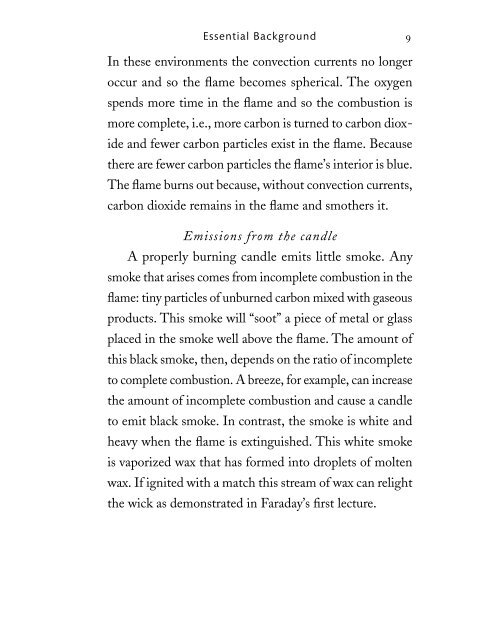Michael Faraday's The Chemical History of a Candle
Michael Faraday's The Chemical History of a Candle With Guides to Lectures, Teaching Guides & Student Activities by Bill Hammack & Dos DeCoste
Michael Faraday's The Chemical History of a Candle With Guides to Lectures, Teaching Guides & Student Activities by Bill Hammack & Dos DeCoste
Create successful ePaper yourself
Turn your PDF publications into a flip-book with our unique Google optimized e-Paper software.
Essential Background<br />
9<br />
In these environments the convection currents no longer<br />
occur and so the flame becomes spherical. <strong>The</strong> oxygen<br />
spends more time in the flame and so the combustion is<br />
more complete, i.e., more carbon is turned to carbon dioxide<br />
and fewer carbon particles exist in the flame. Because<br />
there are fewer carbon particles the flame’s interior is blue.<br />
<strong>The</strong> flame burns out because, without convection currents,<br />
carbon dioxide remains in the flame and smothers it.<br />
Emissions from the candle<br />
A properly burning candle emits little smoke. Any<br />
smoke that arises comes from incomplete combustion in the<br />
flame: tiny particles <strong>of</strong> unburned carbon mixed with gaseous<br />
products. This smoke will “soot” a piece <strong>of</strong> metal or glass<br />
placed in the smoke well above the flame. <strong>The</strong> amount <strong>of</strong><br />
this black smoke, then, depends on the ratio <strong>of</strong> incomplete<br />
to complete combustion. A breeze, for example, can increase<br />
the amount <strong>of</strong> incomplete combustion and cause a candle<br />
to emit black smoke. In contrast, the smoke is white and<br />
heavy when the flame is extinguished. This white smoke<br />
is vaporized wax that has formed into droplets <strong>of</strong> molten<br />
wax. If ignited with a match this stream <strong>of</strong> wax can relight<br />
the wick as demonstrated in Faraday’s first lecture.


